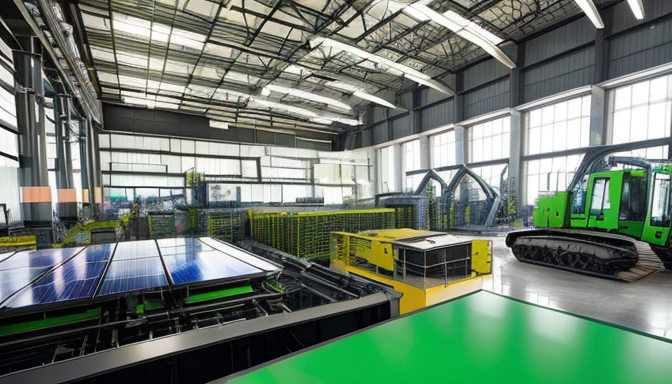The manufacturing landscape is undergoing a dramatic transformation, and it’s nothing short of exciting! With the rapid pace of change in technology and consumer preferences, manufacturers are finding innovative ways to stay ahead of the curve. Imagine a world where automation and artificial intelligence work hand-in-hand to streamline production lines, making them not only faster but also smarter. This isn’t just a dream; it’s happening right now as companies embrace these advancements to enhance efficiency and reduce costs.
But it’s not all about technology. As we face growing environmental challenges, manufacturers are also stepping up their game in terms of sustainability. They are adopting eco-friendly materials and implementing practices that significantly reduce waste. For instance, many are now focusing on circular economy principles, where products are designed for reuse and recycling. This shift not only meets consumer demand for greener products but also aligns with stricter regulatory standards. Who wouldn’t want to be part of a solution that helps the planet?
In this ever-evolving market, staying competitive means being adaptable. Manufacturers are not just reacting to changes; they are proactively shaping the future. From integrating cutting-edge technologies to embracing sustainable practices, the industry is on a thrilling journey of transformation. So, buckle up! The future of manufacturing is bright, and it’s full of opportunities for those ready to innovate.
Technological Innovations in Manufacturing
The manufacturing landscape is undergoing a remarkable transformation as companies embrace cutting-edge technologies to stay ahead of the competition. Imagine a factory where machines communicate with each other, optimizing production in real time. This is no longer a futuristic dream; it’s happening right now. Automation, Artificial Intelligence (AI), and the Internet of Things (IoT) are at the forefront of this revolution, enabling manufacturers to enhance efficiency, reduce costs, and improve product quality.
For instance, automation has streamlined processes that once required extensive human labor. With robots taking over repetitive tasks, workers can focus on more complex and creative aspects of production. This not only boosts productivity but also elevates job satisfaction. But that’s just the tip of the iceberg! AI is revolutionizing decision-making by analyzing vast amounts of data to predict trends and optimize supply chains.
Moreover, the integration of IoT devices allows for real-time monitoring of equipment, leading to predictive maintenance that minimizes downtime. Imagine knowing when a machine is about to fail before it actually does! This proactive approach significantly cuts costs and enhances operational efficiency.
In summary, the adoption of these technological innovations is not just about keeping up with the times; it’s about redefining the future of manufacturing. As companies continue to innovate, the possibilities are endless, paving the way for a more efficient and sustainable industry.

Sustainability Practices in Manufacturing
As we navigate through an era where the environment is at the forefront of global conversations, manufacturers are stepping up their game. It’s not just about cranking out products anymore; it’s about doing so in a way that respects our planet. Companies are now integrating sustainability practices into their operations, and the shift is nothing short of revolutionary. Imagine a world where factories operate like ecosystems, minimizing waste and optimizing resources. Sounds like a dream, right? Well, it’s becoming a reality!
One of the most impactful changes is the adoption of eco-friendly materials. Manufacturers are increasingly sourcing materials that are not only efficient but also sustainable. This means using biodegradable plastics, recycled metals, and renewable resources. By doing so, they are not just appealing to environmentally conscious consumers but are also complying with stricter regulations. For instance, many companies are now measuring their carbon footprint and actively working to reduce it through innovative practices.
Moreover, the integration of circular economy principles is gaining traction. This approach emphasizes reusing and recycling materials, ensuring that products have a lifecycle that extends beyond their initial use. Take a look at the table below for some key sustainability practices being adopted:
| Practice | Description |
|---|---|
| Waste Reduction | Minimizing waste through efficient resource management and recycling. |
| Energy Efficiency | Utilizing renewable energy sources and optimizing energy use in production. |
| Eco-friendly Packaging | Using biodegradable or recyclable materials for packaging products. |
In conclusion, the shift towards sustainability in manufacturing is not just a trend; it’s a necessary evolution. By embracing these practices, manufacturers are not only securing their future but also contributing to a healthier planet. So, the next time you purchase a product, consider the journey it took to get to you and the efforts made to ensure it’s as sustainable as possible!
Frequently Asked Questions
- What are the key technological innovations in manufacturing today?
Manufacturers are embracing cutting-edge technologies like automation, artificial intelligence (AI), and the Internet of Things (IoT). These innovations are not just buzzwords; they are revolutionizing how production lines operate, making processes faster, smarter, and more efficient.
- How are manufacturers addressing sustainability?
With growing environmental concerns, many companies are shifting towards sustainable practices. This includes minimizing waste, conserving resources, and utilizing eco-friendly materials. It’s not just about compliance; it’s about meeting consumer expectations and ensuring a healthier planet.
- Why is adaptability crucial for manufacturers?
In a world where change is the only constant, manufacturers must adapt or risk falling behind. Staying competitive means being open to new technologies, market trends, and customer preferences. Think of it like surfing; the best surfers know how to ride the waves, not just wait for the perfect one.